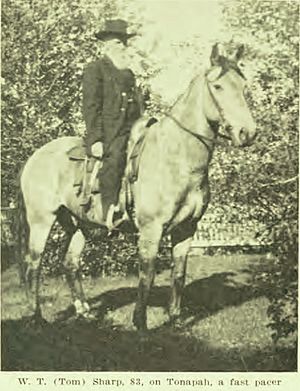Tom Sharp (trader) facts for kids
Quick facts for kids
William Thomas Sharp
|
|
|---|---|

Sharp, circa 1921
|
|
| Born | May 30, 1838 |
| Died | November 26, 1929 (aged 91) |
| Spouse(s) |
Katherine Durrette
(m. 1871) |
| Children | 3 |
William Thomas "Tom" Sharp (born May 30, 1838 – died November 26, 1929) was an interesting American explorer and businessman. He was once a soldier for the Confederate Army during the American Civil War. After the war, he became famous for running a trading post along the historic Taos Trail. He also started a town in Colorado called Malachite, which no longer exists today. This town was located by the Huerfano River in Huerfano County, Colorado. Tom Sharp also became very well-known across the country for breeding high-quality horses and cattle.
Contents
Early Life and the Civil War
William Thomas Sharp was born in Hannibal, Missouri on May 30, 1838. When the American Civil War began, he joined the Confederate Army. He served under a leader named Major General Sterling Price. Early in the war, Tom Sharp was hurt several times. Because of his injuries, he was allowed to leave the army. After this, he traveled west in a wagon.
Sharp's Adventures and Businesses
Exploring the West
Tom Sharp loved to travel and explore. In 1859, he took a trip to Pikes Peak in Colorado. After his time as a soldier, he continued to travel across the American West and even into British Columbia until 1868. During these years, he worked as a gold prospector, searching for valuable minerals. He also helped build railroads.
Sharp worked with a man named "Old Tex" to supply meat to mining camps. These camps were places where miners lived in California and Oregon. By 1867, he was in Cheyenne, Wyoming. There, he helped provide large wooden poles for the Union Pacific Railroad's telegraph lines. He also worked as a deputy sheriff, helping to keep the peace.
Running a Trading Post
In the fall of 1868, Sharp arrived in the Huerfano Valley with two friends. A man named Captain Charles Deus convinced him to stay. Sharp first lived in a small cabin with his wife. In 1870, he built a trading post called Buzzard's Roost Ranch. It was made of logs and adobe, a type of mud brick. He later moved into the trading post itself.
The trading post got its name because hundreds of buzzards would rest in the cottonwood trees nearby. It was located very close to an old trail over Mosca Pass. This trail was used by Native American tribes like the Apache, Comanche, and Utes. French fur trappers also began to use these trails.
Sharp traded with the Utes, who liked the fancy military uniforms he brought in. Chief Ouray, a famous Ute leader, and his wife Chipeta often visited. Their tribe would camp near the trading post in the winter. European settlers also used the Trapper's Trail to travel through Sangre de Cristo Pass to the San Luis Valley and Taos, New Mexico. Sharp sold many different goods that arrived by wagon train. He even hosted horse races for both Native Americans and settlers.
Founding Malachite Town
Tom Sharp believed gold would be found in Pass Creek. So, in 1870, he started a new town called Malachite on his land. It was about a mile from his trading post. The town had several houses made of wood and adobe. Even though a huge gold rush didn't happen, enough gold was found to support a stamp mill. This mill, along with a flour mill, was run by Captain Deus.
For a while, Malachite was a busy community. It had a post office from 1880 to 1915. It was also on a long post road that connected Walsenburg, Colorado and Alamosa, Colorado. However, over time, businesses moved to the nearby town of Gardner, Colorado. Because of this, Malachite eventually became an abandoned town.
Becoming a Livestock Breeder
By 1876, the Ute tribes were moved to reservations. This changed how Sharp did business. He started to focus on breeding animals. He brought in purebred horses from places like France, England, and Kentucky. He would then breed them with the strong ponies that Native Americans had owned. His horses became nationally famous.
Sharp also raised white-faced Hereford cattle. These cattle had special brands called the Lazy S Bar and Reverse S Bar. He was very active in the Cuerno Verde Livestock Association, even serving as its president. He also helped with the Colorado State Fair, promoting it and working as the superintendent for the horse department.
Personal Life
Tom Sharp's wife, Katherine Durrette, was born in Missouri in 1844. They got married in Missouri in 1871. They had three children named William, Emma, and Elizabeth. Tom Sharp passed away on November 26, 1929.

